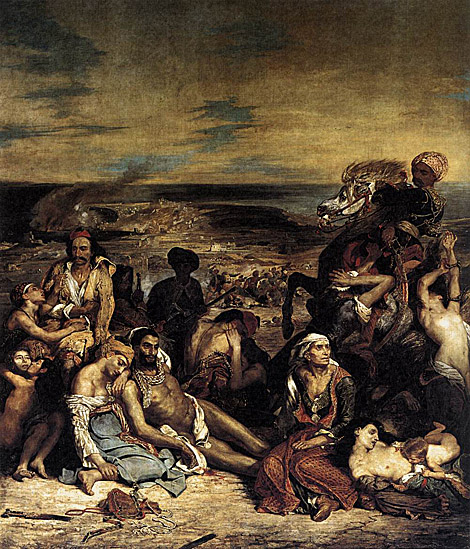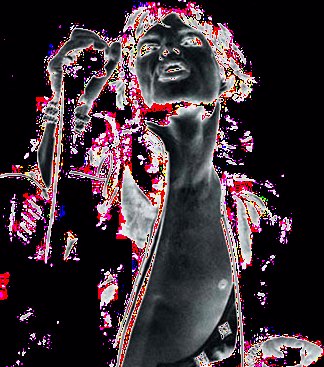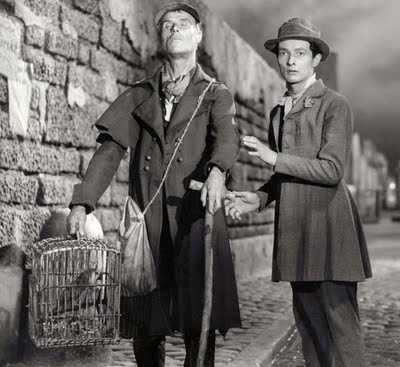It was while he was still a student that Berlioz discovered Shakespeare; ”Shakespeare and Goethe! The mute witness of my torments, who have explained my whole life to me”, and he simulataneously fell in love with the blond Irish actress Harriet Smithson, who had come to Paris to play Juliet and Ophelia with Charles Kemble’s touring company. The initial shock was almost more than he could bear: ”I could not sleep, I lost my spirits, my favorite studies became distasteful to me, I could not work, and I spent my time wandering aimlessly about Paris…”

www.hoocher.com ''A spectacular illustration of the enthusiasm aroused amongst the romantic youth by the revolt of the Greeks against the Turks, the Massacre at Chios was directly inspired by the savage Turkish repression of the population of the island of Chios in April 1822. The critics at the Salon of 1824 received this fine painting very unfavourably. Delacroix had been inspired by Constable's Hay-Wain, which was exhibited at the same Salon, reworking the landscape background with a vibrant touch. Horrified by the massacres perpetrated in Greece by the Sublime Porte, Delacroix denounced this crime against humanity - this genocide. His denunciation took immediate form in The Massacre of Chios; his gesture parallels that of his fervent admirer, Picasso, in his representation of the massacre at Guernica.''
It was as totally unrequited as any passion could be; for several years he did not even succeed in being introduced to Miss Smithson. But out of this feckless experience was born the idea of a ”Symphonie Fantastique” relating an equally anguished ”episode in the life of an artist”. Berlioz scenario for that symphony tells of a lovesick musician who takes a nearly fatal overdose of opium and sees his beloved, his ”idee fixe” , in a series of feverish visions; at a crowded ball, in the solitude of the country, and after he has been led to the scaffold for murdering her, at an orgy of demons on the witches’ Sabbath. Most of these ingredients will be familiar to readers of Mario Praz’s ”The Romantic Agony”; the intermingling of love and death, the attraction of the fatal woman, ”la belle dame sans merci” , and the sadistic finale in the shadow of the divine marquis.

''Mario Praz’s book, The Romantic Agony was published in 1933. I happen to think that my psychedelic Jagger image is just as appropriate to a discussion of it as the 16th century paintings that grace the cover of my Oxford paperpack edition. Probably more so, though Mario would have probably vomited at the thought of Jagger on the cover of his book.''
In the text, Praz delves in great detail into the morbid sexual imagery that infuses much of romantic literature during the 19th century. He sets the stage for what will come in his discussion of authors down to the time of the Symbolists and Decadents, and D’Annunzio.”Finally, I must quote Praz on the Divine Marquis:
‘Let us give Sade his due, as having been the first to expose, in all its crudity, the mechanism of homo sensualis, let us even assign him a place of honour as a psychopathologist and admit his influence on a whole century of literature; but courage (to give a nobler name to what most people would call shamelessness) does not suffice to give originality to a thought, nor does the hurried jotting down of all the cruel fantasies which obsess the mind suffice to give a work mastery of style…The most elementary qualities of a writer – let us not say, of a writer of genius – are lacking in Sade.’

''One of the richest embodiments of romantic agony in 20th-century art, Children of Paradise still rules the seas of French cinema like some proud galleon, the ultimate exemplar of classical filmmaking, great acting, and a perfectly constructed screenplay. For many critics, it remains the finest French film ever made. -Peter Cowie.''
Such wonderful good sense! Such a sure grasp of values! Much as I love the surrealists, I always found their championing of Sade a little tiresome. The fact is, Sade is boring! He is not a fine writer. People who regard any discussion of sex or perversion as thrilling may find him congenial, but he really only has three or four things to say, and he says them at length, over and over.” ( Journey to Perplexity)
In ”Fantastique” some of the central themes of romanticism are drawn together in a psychological web, at the center of which , like a giant spider, sits the artist’s voracious ego , pursuing his quarry, first in one direction, then another. The conception is utterly romantic, and yet the music has none of the murkiness of texture that one associates with the other ”confessional” symphonies of the nineteenth-century. Berlioz’s sound is lyrical and translucent, almost Mozartean, and even the explosive ”March to the Scaffold” , a major breakthrough in percussion scoring, is structurally as classical as any march of Beethoven’s.
The first performance of the ”Fantastique” , on December 5, 1830, ushered in a new epoch for musicians, just as the premiere of Victor Hugo’s ”Hernani” nine months earlier had sounded the starting signal for a literary revolution. Franz Liszt, who was present at the concert, and afterward made a piano transcription of the ”Fantastique” , tells us that tis was a turning point in his life ”Those who watched the fires of genius consume the ancient , skeletons all attached themselves to that
ool of which Berlioz was the most gifted, audacious and brilliant representative”.It has to be remembered that Berlioz made some flamboyant statements in his times, and his comments are littered with the beliefs, prejudices and narcissism that filled the launch of the romantic movement and bohemian conceptions of art. he was anti-modulation and believed harmony to be an uncivilized invention. At that time, people were not generally disposed to accept that in harmony, melody and modulation, what sounded good was good and what sounded bad was just that. Thus, the debate between music as exclusive to sound marked this further transition from the classical to the romantic period, and sparked a reflection on the relationship of tonality to the two schools of thought.
”‘Every sounding object employed by the composer is a musical instrument.’ I wonder if Berlioz would have clung to this maxim if closely questioned on it. He was normally less liberal in his approach to composition and orchestration and did indeed contradict the principle in an essay on imitation in music published in 1837:
Several composers have made fools of themselves imitating certain noises by using the very noises themselves in all their anti-musical reality. An Italian composer, for example, whose name escapes me, wrote a symphony on the death of Werther and decided he could best imitate the suicide’s pistol shot by having an actual pistol discharged in the orchestra; this is the height of absurdity. When M´ehul and Weber wanted to render gunfire, the one in the overture to Le jeune Henri, the other in the infernal hunting scene in Der Freisch¨utz, they found the solution in a simple timpani stroke carefully placed without transgressing the rules of their art.” ( Hugh MacDonald )







 COMMENTS
COMMENTS